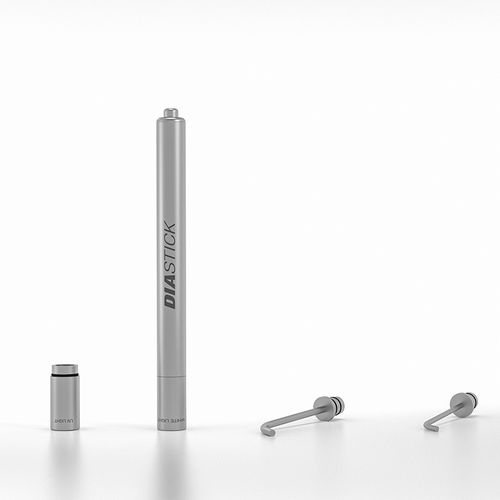
- Products
- Catalogs
- News & Trends
- Exhibitions
Transillumination caries detector DIA-STICKfluorescence
Add to favorites
Compare this product
Characteristics
- Other characteristics
- transillumination, fluorescence
Description
The caries probe with specially polished surface was developed for the early detection of approximal caries. Clinical studies have shown that more than twice as many carious defects can be detected with the help of transillumination compared to normal probes and mirrors. It has also been proven that fibre optics reveal more dental caries than X-ray examinations, as demonstrated by studies of Prof. Dr. Pieper.
The DIA-STICK set consisting of:
· Handpiece
· White Light
· Universal probe
· Batteries LR1
· UV Light (optional)
DIA-STICK with White Light and UV Light
The handle of the device has been improved: an interchangeable attachment set allows easy switching between White Light and UV Light.
The UV Light attachment allows composite materialto be made visible. This technology exposes undesirable material residues when placing and removing composite fillings.
Introduction
Fibre-optic trans-illumination (FOTI) of the hard tooth structure using a light probe was introduced three decades ago for the purpose of detecting tooth decay. Since then, there has been controversy over its value, and in particular, the issue of whether trans-illumination is capable of replacing radiographic diagnosis
In fact, fibre-optic trans-illumination by light probe is a radiation-free, fast and inexpensive addition to clinical examination. The combination of all information obtained through visual examination, FOTI and x-ray imaging enhances the diagnosis of approximal carious lesions. The monitoring of caries during regular check-ups is significantly facilitated through the use of the cold light diagnostic probe.
Catalogs
No catalogs are available for this product.
See all of I.C.Lercher‘s catalogsRelated Searches
- CMOS camera
- USB camera
- I.C.Lercher binocular loupe
- I.C.Lercher glasses-type binocular loupe
- Head-light
- LED head-light
- Camera with LED light
- High-definition camera
- Surgical head-light
- Head-light with rechargeable battery
- Dental camera
- Dental head-light
- Binocular loupe head-light
- Veterinary head-light
- Magnifying head-light
- Caries detector
- Transillumination caries detector
- Fluorescence caries detector
*Prices are pre-tax. They exclude delivery charges and customs duties and do not include additional charges for installation or activation options. Prices are indicative only and may vary by country, with changes to the cost of raw materials and exchange rates.

